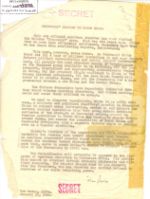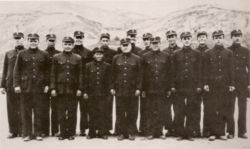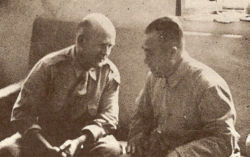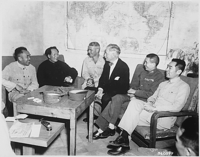Dixie Mission
2007 Schools Wikipedia Selection. Related subjects: World War II
| U.S. Army Observation Group to Yan'an | |
|---|---|
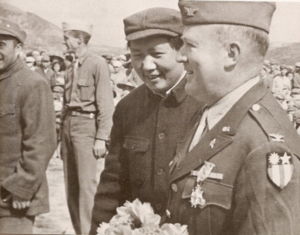 Colonel David Barrett with Mao Zedong |
|
| Active | 22 July, 1944 - 11 March, 1947 |
| Country | United States of America |
| Branch | Army and Navy |
| Part of | China Burma India Theatre |
| Nickname | Dixie Mission |
| Commanders | |
| Notable commanders |
Colonel David D. Barrett |
The United States Army Observation Group, commonly known as the Dixie Mission, was sent during World War II to Yan'an, China, to establish the first official relations between the Communist Party of China and the United States of America. It lasted from 22 July 1944 to 11 March 1947.
The goal of the mission, beyond the establishment of relations with the Communists, was to investigate the communists from a political and military perspective. This task was spearheaded by John S. Service of the United States Department of State, covering the political perspective, and Colonel David D. Barrett of the United States Army who was responsible for the military aspects. Their initial reports presented a positive outlook on the Chinese Communists as a potential and useful wartime ally. Controversy later surrounded their reports as opinions in Washington adopted a more negative stance towards the communists. Eventually, many of the men associated with the reports were condemned by pro- Chinese Nationalist factions in the American government and fell victim to McCarthyism. Service was arrested and fired from his position at the State Department, and Barrett was denied a promotion to brigadier general.
The Dixie Mission also played host to both the Patrick Hurley and George Marshall diplomatic missions, which were serious attempts by the United States government to negotiate a unification of the Chinese Communists and Nationalists. Both failed, but the brief existence of the mission later became a positive shared experience between the People's Republic of China and the United States during the administration of President Richard M. Nixon.
Origin
Plans for a military mission in Chinese Communist territory preceded the development of the Dixie Mission, such as an unimplemented idea by the Office of Strategic Services to send agents into north China. The first major impetus for the Dixie Mission began with a memo written on January 15, 1944, by John Paton Davies, Jr., a Foreign Service Officer serving in the China Burma India Theatre (CBI). The memorandum called for the establishment of an observers' mission in Chinese Communist territory. Davies listed several reasons. First, the communists offered attractive strategic benefits in the fight against Japan. Second, the more the United States ignored the communists, the closer Yan'an would move to Moscow. With the support of Davies' superior, General Joseph Stilwell, this memorandum successfully convinced the administration of Franklin D. Roosevelt to put the plan into motion.
While the first team members were being assembled, such as John S. Service and Colonel David D. Barrett, the Roosevelt Administration sought the permission of Chinese Nationalist president Chiang Kai-shek to send an American observer group to visit the communists. Initially, Chiang was less than forthcoming and the matter was batted back and forth between Chungking (the Nationalists' wartime capital) and Washington. Further pressure was added on the Generalissimo after a party of foreign correspondents whom Chiang had permitted to visit Yan'an reported favorably of the communists to their news sources back in the United States. The matter was finally and successfully resolved after a state visit to Chungking by American Vice-President Henry Wallace in late June of 1944. Assisted by John Carter Vincent, an experienced China expert from the State Department, the mission in what emerged as its final form was negotiated between Wallace and Chiang. The Americans were allowed to go to Yan'an, without Nationalist supervision, and the United States promised to send a new representative for Roosevelt to work with Chiang, as the Generalissimo could no longer abide the presence of the current American commander, General Stilwell . In effect, Stilwell's position in charge of the China Burma India Theatre had also been decided at the conference as the price for permission to visit the communists. He was removed from command in October 1944.
The Mission arrives in Yan'an
The first arrivals
The first part of the Dixie Mission arrived in Yan'an on July 22, 1944, on an Army C-47. This team consisted of: Colonel David D. Barrett, John S. Service, Major Melvin A. Casberg, Major Ray Cromley, Captain John C. Colling, Captain Charles G. Stelle, Captain Paul C. Domke, 1st Lieutenant Henry S. Whittlesey, and Staff Sergeant Anton H. Remeneh.
The second half of the team arrived the next month on August 7th and consisted of: Raymond P. Ludden, Lieutenant Colonel Reginald E. Foss, Major Wilbur J. Peterkin, Major Charles E. Dole, Captain Brooke Dolan, Lieutenant Simon H. Hitch, 1st Lieutenant Louis M. Jones, Sergeant Walter Gress, and Technician 4th Class George I. Nakamura. As time progressed, other members joined the mission.
At work in Yan'an
The Americans immediately set themselves to their tasks of discovering as much as they might about the Chinese Communists. John Service, while technically under Stilwell's command, served as a diplomatic observer for both Stilwell and the American Embassy in Chungking. Over the next three months, he sent a flurry of reports back to Chungking. Controversial from the start, many of Service's reports praised the communists as Agrarian Reformers more akin to European socialists than the feared Russian Bolsheviks. Service also praised the communists for what appeared to be a clean and superior society compared to that of the Chinese Nationalists. Indeed, what Service witnessed in 1944 in the communist areas stood in stark contrast to the corruption and chaos he had seen in the Nationalist areas controlled by Chiang Kai-shek. Whether this constituted a "bias" rather than reasonable, highly defensible observations is debatable In the atmosphere of Yan'an, Service adopted a stronger position and supported the stance that the United States should forsake the Nationalists for the Communists. This opinion was shared with John Paton Davies, and the future careers of both men were ruined for it.
On the military side of the mission, Colonel David Barrett set about evaluating the communists' military potential. This involved observing war games between communist troops and visiting war schools setup to train the communist officer corp. Barrett's reactions were mixed, as he felt the communists put more emphasis on doctrination of their soldiers than actual military training. He believed, however, that American advisors could turn the communist soldier into an excellent fighter.
The Chinese Communists had created a reputation for engaging and attacking the Japanese regularly, most often in guerrilla raids, that dutifully impressed the Americans. In reality, the last significant military campaign by the communists against the Japanese had occurred four years earlier in the Hundred Regiments Campaign by the Chinese Communist 8th Route Army. Ultimately a disaster, the communists decided to hold back on any further large campaigns against the Japanese, but still successfully sold the image of themselves as active fighters.
Diplomacy at Dixie
The Hurley Mission
On 7 November 1944, General Patrick Hurley arrived in Yan'an. Hurley had been in the CBI theater since August, sent as part of an agreement between Wallace and Chiang to provide a liasion for Chiang to directly communicate with Roosevelt without going through Stilwell. Famous as a negotiator in the private sector, Hurley had arrived in China with the mission to help smooth the flow of operations in the China theatre, which he immediately extended to uniting the Nationalists and communists into a unified government. An ill-fated mission from the start, Hurley approached it with little to no knowledge of either political group under the belief that their differences were no greater than those between the Republican and Democratic parties back home in the United States. Hurley failed at reconciliating the Nationalists and Chinese Communists and proceeded to blame this failure on several of the Dixie Mission members, such as John Service and John Paton Davies.
The Marshall and Wedemeyer Missions
In the post-war period immediately following the Japanese surrender, hostilities between the Nationalists and the communists had proliferated between the two. Prior to the Japanese invasion in 1937, the two parties had been at all out war for control of China and had only adopted a tenuous cease-fire under the threat of the Japanese dominance. In 1946, President Harry S. Truman sent General George C. Marshall to China to attempt to negotiate a ceasefire and to form a unified government between the communists and the Nationalists. While most of his time was spent in Chungking, the Dixie Mission played host to Marshall when he arrived in Yan'an to speak with the communist leadership. Like the Hurley Mission, Marshall failed to find a lasting compromise for both parties and the Chinese Civil War resumed.
Shortly after the failure of the Marshall Mission, Truman once again sent a representative to the fractured country. This time he selected the former commander of American troops in China during the war, General Albert Wedemeyer. Again, the American mission in Yan'an played host to a presidential mission. Wedemeyer's trip, rather than repeat the fruitless gesture of attempting to unify the communists and Nationalists, was purely a fact finding mission to establish the state of both groups. Wedemeyer's report stated that it was in America's best interest to continue supporting the Kuomintang, the sole party of the Chinese Nationalist government. However, the report was suppressed as Truman had already adopted the "wait and see" policy in dealing with the Nationalists. In essence he refused to give the Nationalists any aid for fear of direct American involvement in the Chinese Civil War. Wedemeyer's presence served as a sign of the coming end, as shortly thereafter, the Americans packed up their base of operations and liquidated everything that could not easily be transported aboard a C-47. On 11 March 1947, the last Americans departed Yan'an.
The question of Communist subterfuge
One criticism of the early Dixie Mission participants, such as John Service, was that they were deceived by the communist leadership into viewing the communists as socialist agrarian reformers, who claimed that China under their rule would not follow the violent path of Russia under the Bolsheviks. Instead, socialism would come to China only after economic reforms that preserved capitalism, so as to mature the society to a point where it would be prepared for a peaceful transition to a communist society. This belief was disseminated to the American people prior to and during the war by the popular authors Edgar Snow and Agnes Smedley. In his August 3rd, 1944, report, "The Communist Policy Towards the Kuomintang," Service underlined his opinion of the Communists as such and stated:
"And the impressive personal qualities of the Communist leaders, their seeming sincerity, and the coherence and logical nature of their program leads me, at least, toward general acceptance of the first explanation -- that the Communists base their policy toward the Kuomingtang on a real desire for democracy in China under which there can be orderly economic growth through a stage of private enterprise to eventual socialism without the need of violent social upheaval and revolution."
In the years after the Dixie Mission, Colonel Barrett reflected upon this position and wrote in his memoir:
"In addition, I had fallen to some extent, not as much perhaps as did some other foreigners, for the "agrarian reformer" guff. I should have known better than this, particularly since the Chinese Communists themselves never at any time made claim to being anything but revolutionaries - period."
The history of the Chinese Communists after takeover offers evidence that they did not follow the slow gradual path of reformers as believed they would by some in 1944. Regardless, Service continued to believe 25 years later that American cooperation with the communists might have prevented the excesses that occurred under Mao Zedong's leadership after the war. John Davies, after the same number of years, in his memoir, Dragon by the Tail, also defended his belief that communists should have been the Chinese ally for the United States, not the Kuomingtang. For Davies, however, it was not a matter if the Chinese Communists were communists, but that such a move was a practical one based on the idea of Realpolitik. Alliance with the Chinese Communists would have kept an alliance from occurring with the Soviet Union, and thus, been beneficial in the Cold War that followed the end of the war. Such beliefs popularly became known as the "Lost Chance" theory, in which the United States missed the opportunity to build a friendly relationship with the Chinese Communists to prevent their later alignment with the Soviet Union. In any case, such men as Service and Davies were reporting in good faith what they saw at the time.
Lasting Impact
The impact of the Dixie Mission unfolded on a personal and national level. On the personal level, many of its participants were later accused of being communists, such as John Davies and John Service. Both men underwent numerous Congressional investigations, which consistently found the men innocent of charges of being communists or disloyal to the United States. This did not prevent institutional bias from being applied, and Service was fired from the State Department, a decision he appealed and ultimately won in a case before the Supreme Court of the United States. Davies was exiled from China, his field of expertise, by Hurley, then hounded from a position in Russia to an inconsequential post in South America, where he resigned and turned to furniture manufacturing. Colonel David Barrett was yet another victim of Hurley's wrath. Hurley accused the colonel of sabotaging his diplomacy between the Nationalists and communists and halted a promotion for Barrett to brigadier general which had been endorsed by the theatre commander, General Albert C. Wedemeyer. Barrett was retained in the China Theatre, but placed in a position of little influence or involvement.
The mission's impact on the national level was through the 1950's and 1960's one of suspicion and the scene of American-Communist conspiracy. The thawing of relations between the Peoples Republic of China and the United States in the 1970's opened up a new chapter for the mission. For the first time, the mission and its participants became the subject of positive scholarship and many of the original participants were among the first Americans invited to visit China in twenty years. In China, the Dixie Mission remains remembered as a positive time between the two nations involved and a symbol of Sino-American cooperation.
The Nickname
While fondly referred to as "Dixie" or the Dixie Mission, the true name of the mission was the United States Army Observation Group to Yan'an. One war scholar attributes the name to the fact that there were a predominant number of Southerners amongst the mission's personnel. John Davies, however, declared in his memoir Dragon by the Tail that the mission earned its nickname due to the reference of communist territory as "rebel" territory by himself and his peers, a glib comparison to the territory of the Confederate States of America.
Notable Members
- Colonel David D. Barrett (1892 - 1977), first commanding officer of the Dixie Mission.
- John S. Service (1909 - 1999), first State Department representative to arrive and operate as part of the Dixie Mission.
- John P. Davies (1908 - 1999), State Department official instrumental in the creation of the mission.
- Raymond P. Ludden (1909 - 1970), State Department officer who undertook dangerous mission into Japanese occupied China.
Dixie Mission Commanding Officers
- Colonel David D. Barrett
- Colonel Morris DePass
- Colonel Wilbur J. Peterkin
- Major Clifford F. Young
- Colonel John Sells
